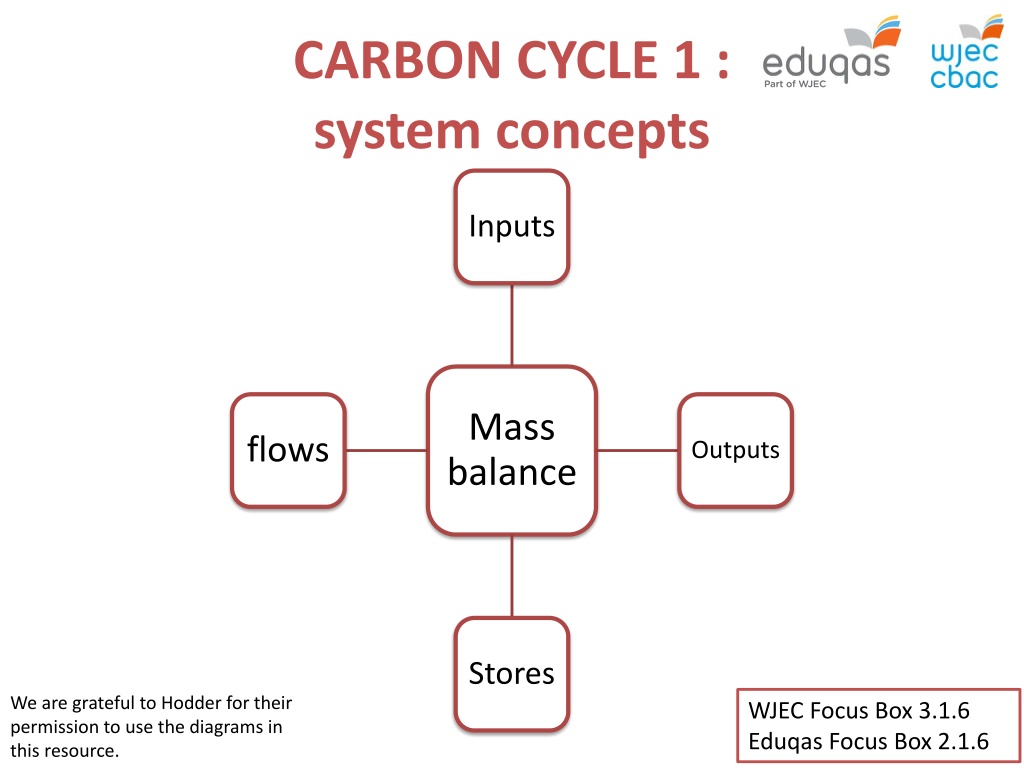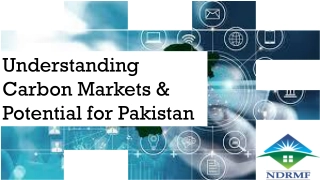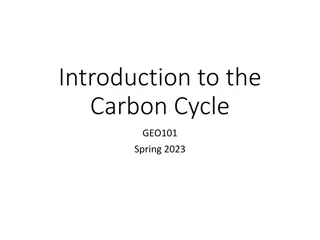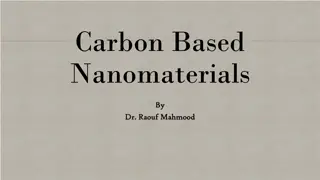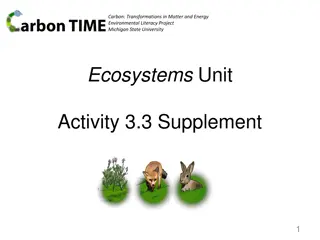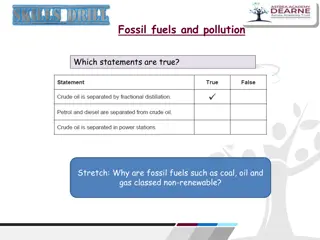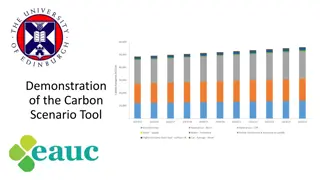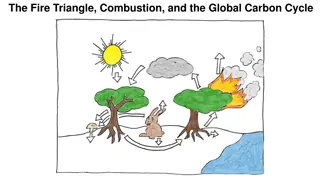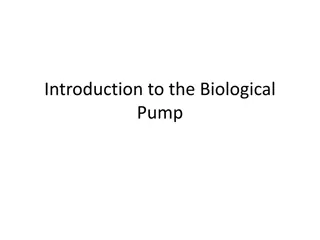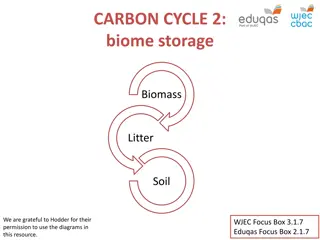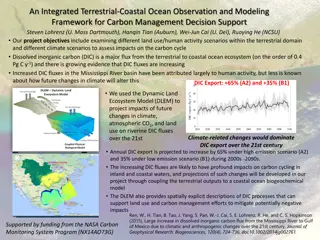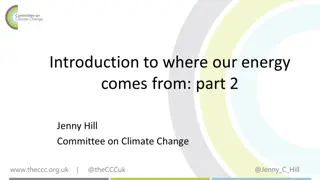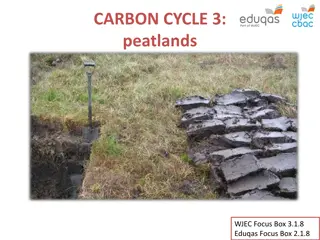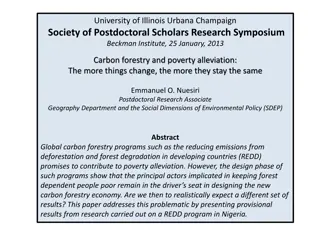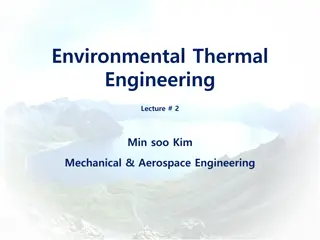The Carbon Cycle: System Concepts and Pathways
The carbon cycle involves the movement of carbon between different stores in the global system, such as the atmosphere, oceans, and biosphere. Flows, inputs, and outputs play crucial roles in this cycle, with processes like photosynthesis and respiration impacting carbon levels. Explore how mass balance concepts are applied to the carbon cycle and understand the interplay of land and atmosphere pathways in carbon flow.
Download Presentation

Please find below an Image/Link to download the presentation.
The content on the website is provided AS IS for your information and personal use only. It may not be sold, licensed, or shared on other websites without obtaining consent from the author.If you encounter any issues during the download, it is possible that the publisher has removed the file from their server.
You are allowed to download the files provided on this website for personal or commercial use, subject to the condition that they are used lawfully. All files are the property of their respective owners.
The content on the website is provided AS IS for your information and personal use only. It may not be sold, licensed, or shared on other websites without obtaining consent from the author.
E N D
Presentation Transcript
CARBON CYCLE 1 : system concepts Inputs Mass balance flows Outputs Stores We are grateful to Hodder for their permission to use the diagrams in this resource. WJEC Focus Box 3.1.6 Eduqas Focus Box 2.1.6
Carbon Cycle 1 Carbon system components Stores are the amounts of carbon held the global system e.g. the atmosphere, oceans and biosphere Flows are movements or transfers of carbon between stores e.g. volcanic activity adds 0.1 gigatonnes of carbon to the atmosphere annually Flows into stores are called inputs e.g. carbon dioxide added to the atmosphere by human activities Flows leaving stores are outputs e.g. dissolved carbon carried from the land in solution by rivers Class activity Which GCSE Geography, Biology and Science topics included knowledge and understanding of carbon?
Carbon Cycle 1 The global carbon cycle The global carbon cycle is shown as a black box model One gigatonne equals one billion tonnes (or one trillion kg). GtC demotes one gigatonne of carbon dioxide equivalent Class activity Discuss how the concept of mass balance can be applied to the carbon cycle (c) Hodder Education [OCR A-level Geography (Raw)]
Carbon Cycle 1 Another view of the carbon cycle Class activity Which GCSE and A-level subjects have you studied which include topics shown in this illustration? (c) Hodder Education [AQA A-level Geography (Skinner)]
Carbon Cycle 1 Carbon pathways: land atmosphere (c) Hodder Education [AQA A-level Geography (Skinner)]
Carbon Cycle 1 Carbon pathways: land atmosphere Process How it works Photo- synthesis water using energy from light. Plants fix gaseous CO2 into solid form in their living tissues The net primary productivity (NPP) of an ecosystem is the rate at which new organic matter is produced by photosynthesis per unit area per unit time Respiration CO2 is released into the atmosphere by organisms through the process of respiration. Plants create energy for respiration by breaking down stored glucose (sugars). CO2 is given off as a by-product Carbohydrate molecules are produced from CO2and Class activity Why do these processes vary in their operation from place to place and time to time?
Carbon Cycle 1 Carbon pathways: land atmosphere Process Decomposition How it works CO2 is returned to the atmosphere when living organisms die: their cells break down as a result of physical (wind and water), chemical (leaching and oxidation) and biological (feeding and digestion) mechanisms (carried out by bacteria and fungi) Hydrocarbon (fossil fuel) combustion takes place rapidly in the presence of oxygen and releases CO2 Around 85 per cent of global energy consumption is derived from coal, oil and gas fuels; traditional societies burn biomass on demand Fossil fuel combustion Class activity Why do these processes vary in their operation from place to place and time to time?
Carbon Cycle 1 Carbon pathways: ocean atmosphere Oceans take up carbon dioxide by two carbon cycle pumps: (1) the biological pump (2) the physical pump Class activity Describe and explain the biological and physical carbon transfers shown taking place (c) Hodder Education (Edexcel A-level Geography (Dunn)]
Carbon Cycle 1 Carbon pathways: ocean atmosphere The physical (inorganic) pump involves the movement of carbon dioxide from the atmosphere to the ocean by a process called diffusion CO2 dissolved in the surface of the ocean can be transferred to the deep ocean in areas where cold dense surface waters sink This downwelling carries carbon molecules to great depths where they may remain for centuries CO2 diffusion determines the acidity of the oceans Class activity What geographical factors might cause the rate of diffusion to vary from place to place or time to time?
Carbon Cycle 1 Carbon pathways: ocean atmosphere The biological (organic) pump is driven by ocean phytoplankton absorbing CO2 via photosynthesis These organisms form the bottom of the marine food web, and live in the ocean s surface layer Phytoplankton are consumed by other organisms and carbon is transferred along food chains Organic carbon may eventually be transferred to the deep ocean when dead organisms sink towards the ocean floor Class activity Using examples, describe how carbon moves through food webs in (1) marine (2) terrestrial ecosystems
Carbon Cycle 1 Carbon pathways: land ocean Cycling of carbon between terrestrial bedrock and oceans occurs over millions of years Rainwater containing weak carbonic acid reacts with Limestone to produce soluble calcium bicarbonate Calcium bicarbonate moves through the water cycle in solution into rivers and the ocean Next, calcium bicarbonate is used by marine organisms to create shells; these are deposited later as carbonate-rich sediment on the ocean floor where they are lithified Class activity Discuss your prior learning of chemical weathering and rivertransport of material in solution
Carbon Cycle 1 Carbon pathways: land ocean Some carbon is eventually returned to the atmosphere by volcanism, when CO2 is released from melted rocks when subduction occurs at plate boundaries Class activity Discuss your existing knowledge of (1) the rate at which tectonic plates move and (2) subduction (c) Hodder Education (Edexcel A-level Geography (Dunn)]
Carbon Cycle 1 Plenary The global carbon cycle consists of stores, flows, inputs and outputs e.g. carbon stored in sedimentary rocks and deep ocean sediments Photosynthesis, respiration, decomposition and fossil fuel combustion are important processes controlling carbon flows between the atmosphere and the land Carbon flows from the atmosphere to the ocean take place via the physical pump and the biological pump A slow carbon cycle operates between the land and the ocean over millions of years, involving carbonation, river transport and plate tectonic movement
